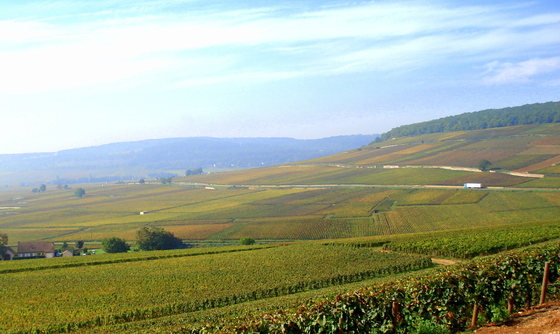The famous Corton vines outside of Beaune at harvest season: each vineyard plot exhibits unique taste characteristics. What makes the difference? Native yeast cultures.

The New York Times headline last week (easy to miss with the holiday weekend approaching) read "Microbes May Add Special Something to Wines," but the article spent most of its 880 words talking not about microbes but terroir. Written by one of the paper's top science reporters, Nicholas Wade, the piece described a project by three UC Davis researchers to identify (and quantify) the factors that make the wine from different vineyards (but same grape varieties) taste different. In the end, they identified microbes.
Deep within the comments we find this:
"But American wine growers have long expressed varying degrees of skepticism about this ineffable concept..."
Seriously? Where did the author find these American skeptical winegrowers? I've been a winegrower for quite a few years and know many, many others. I've never heard of one who denied the existence of terroir.
And then this:
It's the yeast, stupid. It blooms spontaneously on the grape skins shortly before harvest and imparts its unique character to the must, unique by virtue of the vineyard's LOCATION (e.g. "terroir"). If the winery opts to kill the yeast with SO2, it kills the wine's uniqueness.
That second quote is from Cornichon. And it goes to the heart of the California wine establishment's fear of yeast.
There are plenty of arguments in favor of neutralizing yeast cells if the grapes are transported long distances and might develop a spontaneous fermentation before they arrive at the winery; there are arguments in favor of using a "house brand" yeast to produce a "house" flavor of Chardonnay (say).
But look at that photo: in Burgundy's best vineyards, every plot is different, every plot has its own unique yeast cells blooming on the grapes at harvest. Every plot has an owner whose cellars are a five-minute tractor ride away, a winery whose walls and floors have been breathing those yeasts cells for decades. That's why Corton Clos du Roi sells for $100 a bottle. Bouchard, Faiveley, Domaine de Monthille, and Comte Senard (to name but a few) all make tons of wine from a variety of vineyards; they know they'd be cutting their own throats if they were to "standardize" their Corton (to name but one wine). They play up the differences.
Many American vineyards, alas, smooth out the differences, and then finance research that justifies the practice. And "gee whiz" articles like the one in the Times don't help.
Who got it right? A young scientist in New Zealand named Erika Szymansky, who writes a blog called The Wine-O-Scope. Szymansky, who also contributes to The Palate Press, won the Roederer prize for best "emerging wine writer" a year ago. Pay attention to her!
Leave a comment